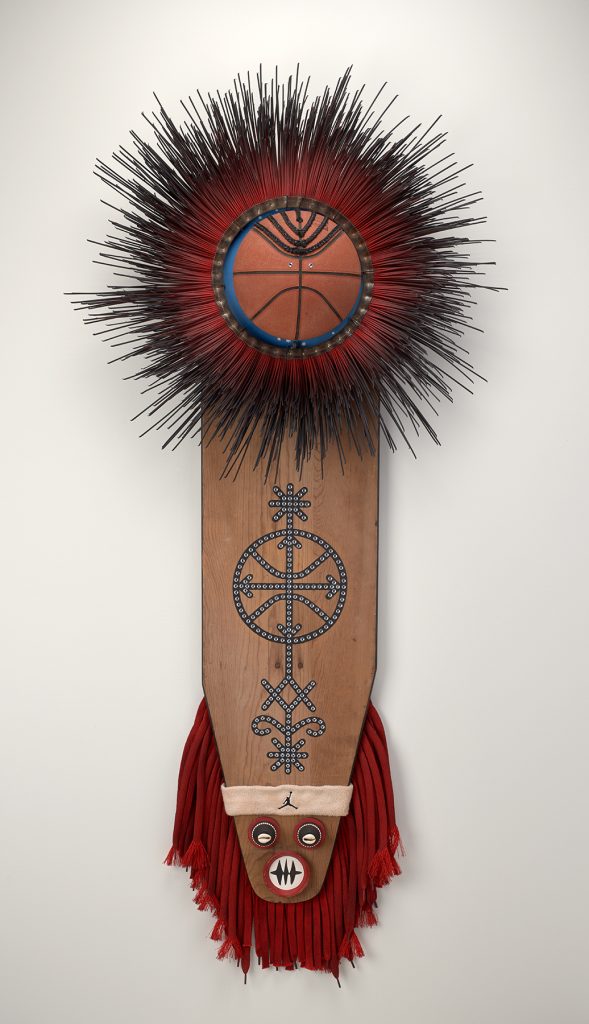Black Magic (It’s Fantastic) (work of art)
Artwork Info
Key Ideas
- Black Magic (It’s Fantastic) is an assemblage sculpture that incorporates symbols of Black culture such as cowrie shells, braided hair, and various basketball-related items such as a ball, shoelaces, and a headband.
- This work pays tribute to the first racially integrated basketball game in the South (between Duke University and North Carolina Central University).
- Artist André Leon Gray was born and raised in Raleigh, where he currently lives and works. Through his work he tells powerful stories about cultural and economic issues in society.
- Although it appears to have a Pan-African influence, this sculpture’s form is similar to plank masks made by the Bwa people of Burkina Faso (a landlocked country in West Africa). Plank masks are wooden face coverings that are often used in rituals, festivals, and various rite-of-passage ceremonies.
Learn More
Black Magic (It’s Fantastic) is part of a series about basketball and black athletes. This work is especially important when taken in a geographic context. North Carolina has played a key role in the desegregation of professional sports. In 1944 an all-white basketball team from Duke University and an all-black basketball team from North Carolina Central University (NCCU) met secretly to play one another in the first racially integrated college basketball game in the American South. The game had to be kept secret from the public and the media because it violated the state’s strict segregation laws.
For many people, this rare moment of racial collaboration and mutual respect felt magical. The “Secret Game” was the beginning of the integration of professional sports, or the “Black Magic” era, as it is now known, as the students from NCCU beat Duke by 119-34. Raleigh-based artist André Leon Gray references this historic event in the title of this work.
“This piece was inspired by African masks and also a little bit of Native American iconography. The idea behind it was more about the appearance of Black athletes in sports, whether collegiate level or professional level, and how they seem to defy gravity. The name…Black Magic…[is] this idea of having this kind of otherworldly powers on the basketball court.”
-André Leon Gray
The sculpture’s form and decoration resemble the plank masks created by the Bwa people in central Burkina Faso, in West Africa. Plank masks are carved out of respect for Bwa ancestors and are used in ritual performances like funerals, agricultural festivals, and rites of passage. Black Magic (It’s Fantastic) incorporates symbols of Black culture, such as cowrie shells that often adorn African ritual objects, braided hair that acknowledges the importance of hairstyling and barbering in Black cultures, and various basketball-related items such as a ball, shoelaces, and a Jordan Jumpman headband.
Additional Resources
Resources for Teachers:
- Read an article about the historic game that inspired this sculpture.
- Watch a video interview with André Leon Gray.
- Watch a video about the history of African-American basketball.
Resources for Students:
- Take a virtual tour of Black Magic (It’s Fantastic).
- Examine a Bwa plank mask from the Metropolitan Museum of Art.
- Watch a CBS News segment about the “Secret Game” between NCCU and Duke University.

